MU90 Impact
The MU90 Impact is an advanced lightweight anti-submarine torpedo of the 3rd generation[3] developed by France and Italy for navies of France, Italy, Germany, Denmark, Australia and Poland. It is designed to compete with and outperform the United States-built Mark 54 in the anti-submarine role, and has also been developed in a special MU90 Hard Kill version for torpedo anti-torpedo defence.[2] The MU90 is built by EuroTorp, a consortium of French and Italian companies.
| MU90 Impact | |
|---|---|
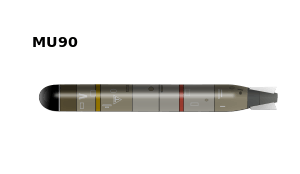 | |
| Type | torpedo |
| Place of origin | Italy France |
| Service history | |
| Used by | Germany, France, Italy, Egypt, Denmark, Australia and Poland |
| Production history | |
| Manufacturer | EuroTorp |
| Unit cost | €1.6m[1] (~US$2.1m)(FY12) |
| No. built | >1000[2] |
| Variants | MU90 Hard Kill |
| Specifications | |
| Mass | 304 kg (670 lb)[2] |
| Length | 2.85 m (112 in)[2] |
| Diameter | 323.7 mm (12.74 in)[2] |
| Warhead | PBX shaped charge warhead |
| Warhead weight | 32.7 kg |
| Engine | Pump-jet Electric |
Operational range | >10 km (5.4 nmi) (max speed) >23 km (12 nmi) (min speed)[2] |
| Maximum depth | >1000 m |
| Maximum speed | 29 kn (54 km/h) to well over 50 kn (93 km/h)[2] |
Guidance system | Active or passive acoustic homing |
Launch platform | Surface ships aircraft |
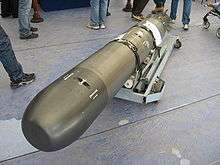
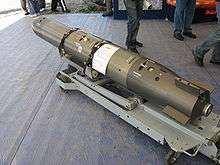
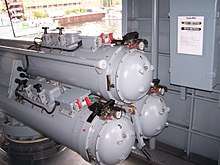
History
The MU90 was the result of separate projects in France and Italy from the 1980s. In France, a project under the direction of Thomson Sintra created the "Murène" in 1989, while in Italy Whitehead started work on an A244 replacement known as the A290. In 1990 the first attempts to merge the two efforts started, a process that was completed in 1993 with the formation of EuroTorp.[4]
The French intended to use the new torpedo on their frigates, Atlantique 2 aircraft, Lynx helicopters and NFH90 helicopters.[1] They originally wanted 1000 units, but the end of the Cold War saw their requirement cut to 600 in 1991, 450 in 2000 and finally 300 torpedoes in 2008.[1] The project has cost France €1,150m (~US$1,500m) in 2012 prices at a unit cost of €1.6m (~US$2.1m), or €3.8m (~US$5m) including development costs.[1] 25 torpedoes per year will be delivered to France until 2014.[1]
Design
The MU90 is capable against any current or perceived threat, including a bottomed stationary mini-submarine, known versions of anechoic coatings, and various decoys. It is also capable of launch speeds up to 400 knots (740 km/h; 460 mph), allowing it to be dropped from maritime patrol aircraft flying at high speeds, or rocket-assist launchers. Powered by an electric pump-jet, it can be run at "silent" speeds to avoid giving its location away to the submarine, or "dash" at speeds over 29 knots.[5] It uses a shaped charge warhead that can penetrate any known submarine hull, in particular Soviet double hull designs, while remaining just as deadly in shallow waters where conventional warheads are less effective.
In 1986 France and Italy began a collaboration to develop an anti-submarine missile based on the Italian Otomat missile. France dropped out of the programme but Italy has fitted the MBDA MILAS missile to its Durand de la Penne-class destroyers and FREMM anti-submarine frigates. MILAS is an 800 kg (1,800 lb) missile that can deliver a MU90 to 35 kilometres (19 nmi).
Exports
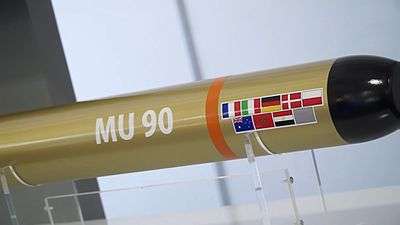
After deciding that its Mark 46 torpedoes were inadequate, Australia set up the JP2070 project in 1998 to buy torpedoes for its Adelaide-class frigates, Anzac-class frigates, AP-3C Orion aircraft, S-70B-2 Seahawk helicopters and planned SH-2G(A) Super Seasprite helicopters.[6] The Seasprites were cancelled and the Orions and Seahawks were removed from the MU90 programme on budget grounds; their replacements, the P-8 Poseidon and MH-60R Seahawk will use the US Mark 54 torpedo.[6] The A$639m[6] project to buy a classified number of MU90 has been heavily criticised by the Australian National Audit Office on the grounds of cost, insufficient test firings which failed to reveal defects in the torpedo, and the lack of commonality with the Navy's air-launched torpedoes. The MU90 reached IOC in November 2012.[6]
Operators
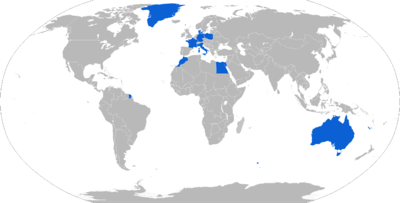
See also
- APR-3E torpedo - Russian equivalent
- A244-S - Italian equivalent
- Mark 54 Lightweight Torpedo - US Navy's equivalent
- Sting Ray (torpedo) - British equivalent
- TAL Shyena - Indian equivalent
- Yu-7 torpedo - Chinese equivalent
References
- "Projet de loi de finances pour 2013 : Défense : équipement des forces" (in French). Senate of France. 22 November 2012. Retrieved 7 November 2013.
- "MU 90/IMPACT". EuroTorp. Archived from the original on 15 July 2015.
- "Formal Acceptance by the French MOD of the First Batch of 25 Eurotorp's Manufactured MU90 Block1 Torpedoes". Naval-technology.com. Retrieved 8 May 2015.
- EUROTORP History Archived 2007-12-09 at the Wayback Machine
- MU90 sales glossy - data brochure Archived 19 September 2013 at the Wayback Machine
- "Remediation of the Lightweight Torpedo Replacement Project". Australian National Audit Office. 28 February 2013. Archived from the original on 26 April 2013. Retrieved 7 November 2013.